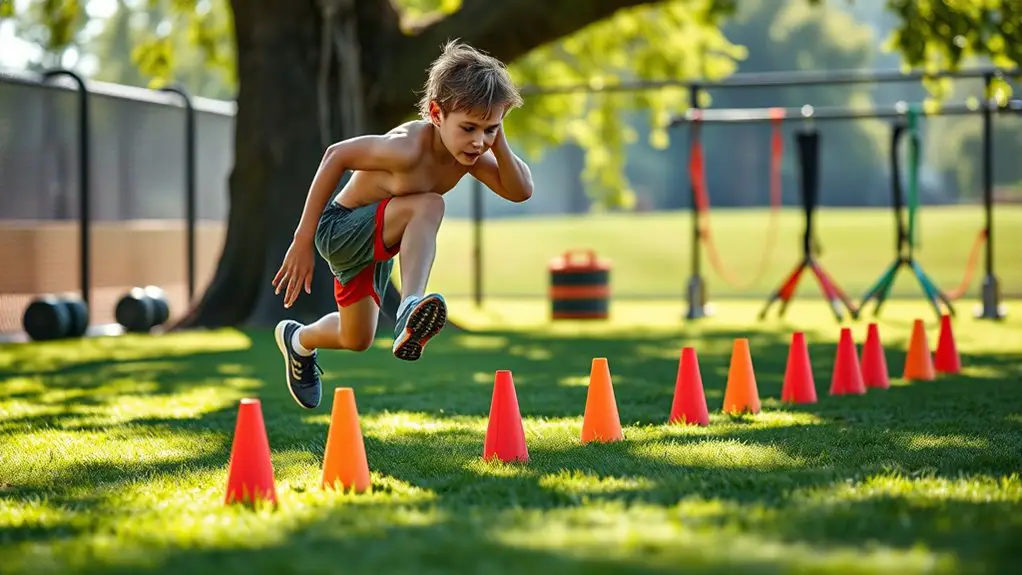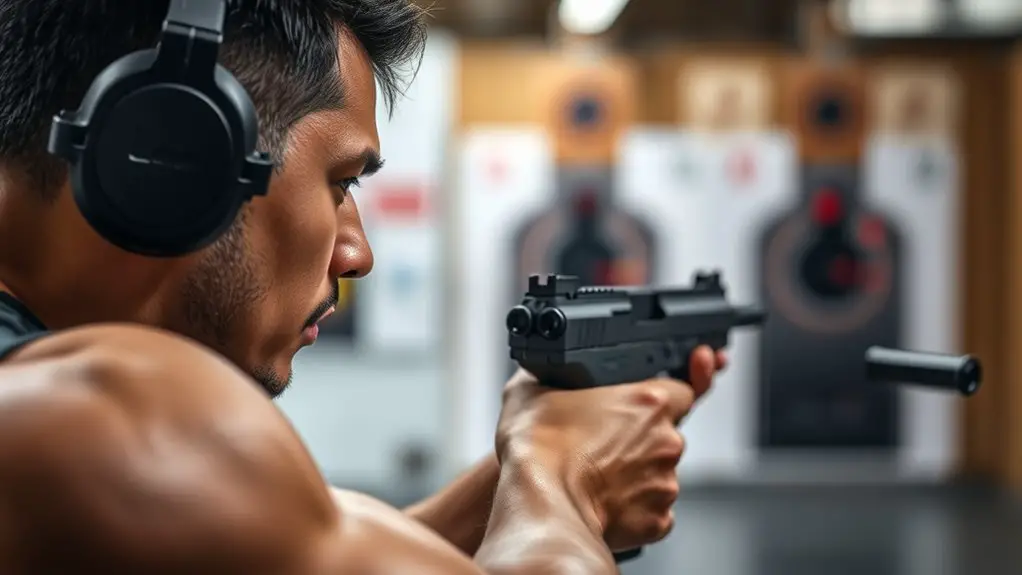To increase your upper-body strength as an athlete, focus on essential exercises like push-ups, pull-ups, and dumbbell bench presses. Incorporate resistance training at least two to three times a week, ensuring you allow for recovery time. Don't forget the importance of proper nutrition, including lean proteins and healthy carbs, to fuel your workouts. Consistency is key, so keep track of your progress and set achievable goals. There's plenty more you can explore to maximize your training potential.
Understanding Upper-Body Muscles and Their Functions
When it comes to athletic performance, understanding upper-body muscles is vital. Your shoulders, chest, back, and arms work together to create powerful movements. The deltoids help in lifting and rotating your arms, while the pectorals drive forward movements like pushing and throwing. Your latissimus dorsi plays an important role in pulling motions, helping you with activities like rowing and climbing. Alongside these, the triceps and biceps are key players in any arm movement, enabling you to lift, push, or pull effectively. By grasping how these muscles function, you can target them during workouts, enhancing your overall strength and performance. Embracing this knowledge gives you the freedom to train wisely and access your full athletic potential.
The Importance of Upper-Body Strength in Sports
Upper-body strength is vital for athletes, as it directly impacts performance across various sports. Whether you're shooting a basketball, throwing a football, or executing a perfect swim stroke, strong arms, shoulders, and back muscles are essential. They not only enhance your ability to generate power but also improve your endurance and stability during competition. When you've got good upper-body strength, you can better control your movements, reducing the risk of injury. Plus, it allows for more explosive actions, giving you a competitive edge. By focusing on your upper body, you're not just building muscle; you're revealing your full potential, allowing for greater freedom of movement. Embrace this strength, and watch your athletic performance soar.
Essential Exercises for Building Upper-Body Strength
To effectively build upper-body strength, incorporating a variety of targeted exercises into your training routine is essential. Start with push-ups, which engage your chest, shoulders, and triceps effectively. Add pull-ups for a great back workout that also challenges your biceps. Dumbbell bench presses can further boost your chest strength while allowing for a full range of motion. Don't forget shoulder presses to enhance stability and power in your upper body. Incorporate rows to develop your upper back and improve posture. Finally, consider planks to strengthen your core, which supports all upper-body movements. With these exercises, you'll not only build strength but also gain the freedom to perform better in your sport. Stay consistent, and you'll see the results!
Incorporating Resistance Training Into Your Routine
Incorporating resistance training into your routine can markedly enhance your athletic performance, as it builds the necessary strength and stability for various sports. It's not just about lifting weights; it's about finding what works for you. Start with compound movements like bench presses and rows, targeting multiple muscle groups at once. Aim for two to three sessions a week, allowing time for recovery. You can mix in resistance bands or dumbbells to keep things fresh and engaging. Don't be afraid to experiment with different exercises to discover what you enjoy most. Remember, consistency is key, so make it a habit. By embracing resistance training, you'll release your potential and enjoy the freedom of improved strength on and off the field.
The Role of Bodyweight Exercises in Upper-Body Development
Bodyweight exercises play an essential role in developing upper-body strength, and they can be performed anywhere, making them incredibly accessible. You don't need a gym or fancy equipment; just your body is enough. Push-ups, pull-ups, and dips are fantastic ways to build muscle and endurance. By using your own weight, you engage multiple muscle groups, enhancing coordination and stability while promoting functional strength. Plus, you can easily modify these exercises to match your fitness level, allowing you to progress at your own pace. This freedom to adapt means you can challenge yourself without the constraints of a traditional workout setting. So, embrace bodyweight training; it's a liberating way to strengthen your upper body and elevate your athletic performance.
The Benefits of Cross-Training for Athletes
While many athletes focus solely on their primary sport, cross-training offers a wealth of benefits that can enhance overall performance. By incorporating different activities into your routine, you can experience:
- Improved strength and flexibility: Engaging in various exercises helps build balanced muscle groups, reducing injury risk.
- Increased endurance: Mixing in cardio workouts increases your stamina, allowing you to perform better in your main sport.
- Mental refreshment: Trying new activities keeps training exciting, preventing burnout and promoting a love for movement.
Cross-training not only enhances your physical capabilities but also cultivates a sense of freedom in your fitness journey. So, don't be afraid to explore different workouts; it's a great way to reveal your full athletic potential!
Tips for Proper Form and Technique
Proper form and technique are essential for maximizing upper-body strength and preventing injuries, especially when you're pushing yourself in training. Start by keeping your core engaged; this stabilizes your body and supports your movements. Maintain a neutral spine, avoiding excessive arching or rounding. When lifting weights, control the speed—don't rush through reps. Focus on your grip; it should be firm but not overly tight, allowing for smoother movement. Pay attention to your range of motion; verify you're not overextending or cutting short your movements. Finally, always listen to your body. If something feels off, don't hesitate to adjust or take a break. Prioritize quality over quantity, and you'll build strength effectively and safely.
Creating a Balanced Upper-Body Workout Plan
Building on the importance of form and technique, creating a balanced upper-body workout plan is key to developing strength effectively. You want to make certain you're hitting all major muscle groups while keeping things fresh and enjoyable. Here's how to do it:
Creating a balanced upper-body workout is essential for effective strength development while ensuring all major muscle groups are engaged.
- Choose Compound Movements: Focus on exercises like push-ups, pull-ups, and bench presses. They engage multiple muscles, maximizing your effort.
- Incorporate Isolation Exercises: Add bicep curls and tricep extensions to target specific muscles, making sure of a well-rounded approach.
- Vary Your Routine: Change up your workouts every few weeks to keep things exciting and prevent plateaus.
Nutrition for Muscle Growth and Recovery
To maximize muscle growth and recovery, you need to pay close attention to your nutrition. Fueling your body with the right nutrients is vital. Focus on consuming lean proteins like chicken, fish, and legumes; they help repair and build muscle. Don't skip healthy fats found in avocados and nuts, as they support hormone production. Carbs aren't your enemy; they provide energy for intense workouts, so load up on whole grains and fruits. Hydration's important too—water aids in recovery and muscle function. Consider timing your meals around workouts for best results. Enjoying a variety of foods keeps things exciting and guarantees you're getting a range of nutrients. Embrace this freedom in your diet, and your body will thank you.
Tracking Progress and Setting Goals for Upper-Body Strength
While many athletes focus solely on their training routines, tracking progress and setting specific goals for upper-body strength is just as essential for success. To guarantee you're on the right path, consider these three strategies:
- Keep a Workout Journal: Document your exercises, weights, and reps. This'll help you identify patterns and areas for improvement.
- Set SMART Goals: Make your goals Specific, Measurable, Achievable, Relevant, and Time-bound. For example, aim to increase your bench press by 10% in six weeks.
- Regular Assessments: Schedule monthly assessments to evaluate your strength gains. This'll keep you motivated and allow you to adjust your training if needed.
Frequently Asked Questions
How Often Should I Train My Upper Body Each Week?
You should aim to train your upper body two to three times a week. This frequency allows for adequate recovery and muscle growth, giving you the freedom to balance workouts with other activities you enjoy.
Can I Improve Upper-Body Strength With Limited Equipment?
Think of your body as a canvas; even with limited equipment, you can create a masterpiece. Bodyweight exercises and resistance bands can sculpt your upper body, giving you freedom to grow stronger wherever you are.
What Are Signs of Overtraining in Upper-Body Workouts?
If you're experiencing persistent fatigue, decreased performance, or trouble sleeping, those might be signs you're overtraining. Listen to your body; it's essential to rest and recover to maintain balance and achieve your fitness goals.
Are There Age-Related Considerations for Upper-Body Strength Training?
As you age, your body's recovery slows, so you might need to adjust your upper-body strength training. Listen to your body, prioritize proper form, and incorporate rest days to maintain strength and prevent injury.
How Do I Prevent Injuries While Training Upper-Body Strength?
Like a dancer gliding gracefully, you should warm up, listen to your body, and use proper form. Gradually increase intensity, and don't ignore rest days—freedom in strength comes from balanced training and mindful care.




